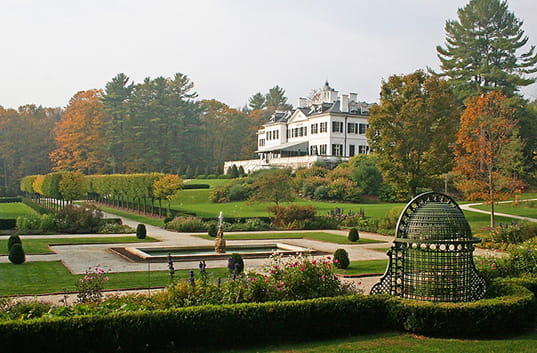
The Mount - Lenox, MA
Contact us
Located in historic Lenox, Massachusetts
218 Main Street, Lenox, MA 01240
Phone: 413.637.2118
Toll Free: 877.532.8671
Fax: 413.637.1120
History of Lenox
With mountains to the east and west, the area remained wilderness into the 18th-century. Hostilities during the French and Indian Wars discouraged settlement until 1750, when Jonathan and Sarah Hinsdale from Hartford, Connecticut established a small inn and general store. For 2,250 pounds Josiah Dean purchased Lot Number 8, which included present-day Lenox and Richmond. After conflicting land claims were resolved, however, it went to Samuel Brown, Jr., who had bought the land from the Mahican chief, on condition that he pay 650 pounds extra.
-
It was founded as Richmond in 1765. But because the Berkshires divided the town in two, the village of Yokuntown (named for an Indian chief) was set off as Lenox in 1767. The town was intended to be called Lennox, probably after Charles Lennox, third duke of Richmond and Lennox (Scottish Gaelic "Leamhnachd"), but the name was misspelled by a clerk at incorporation. Early industries included farming, sawmills, textile mills, potash production, glassworks and quarrying. A vein of iron ore led to the digging of mines under the town, and the establishment by Job Gilbert in the 1780s of an iron works at Lenox Dale, also known as Lenox Furnace. In 1784, Lenox became county seat, which it remained until 1868 when the title passed to Pittsfield.
The county courthouse built in 1816 is today the Lenox Library. The region's rustic beauty helped Lenox develop into an art colony. In 1821, author Catharine Sedgwick moved here, followed by actress Fanny Kemble. Nathaniel Hawthorne and his family came from Salem in 1850, staying a year and a half. Other visitors to the area, including Timothy Dwight, Benjamin Silliman and Henry Ward Beecher, extolled its advantages. After an extension of the Housatonic Railroad arrived in 1838, tourists discovered the town in increasing numbers. In 1844, Samuel Gray Ward of Boston, the American representative for Barings Bank of London, assembled tracts of land to create the first estate in Lenox. Called Highwood, the Italianate dwelling was designed in 1845 by Richard Upjohn.
In 1876, Ward hired Charles F. McKim to design, in the Shingle style, another property, Oakwood. The period from 1880 until 1920 would be dubbed the Berkshire Cottage era, when the small New England town was transformed into a Gilded Age resort similar to Newport, Rhode Island and Bar Harbor, Maine. The wealthy and their entourage opened immense houses for recreation and entertaining during the Berkshire season, which lasted from late summer until early fall. One event was the annual Tub Parade, when Main Street was lined with ornately decorated carriages. Property values jumped as millionaires competed for land on which to build showplaces. In 1903, an acre in Lenox cost $20,000, when an acre in nearby towns cost a few dollars. The imposition of the federal income tax in 1913 ended construction of the country mansions in the Berkshire area.
The estates started to break up during the 1920s. Carnegie’s widow sold Shadowbrook to the Jesuits for a seminary in 1922. The Great Depression made it harder to maintain the estates, and labor was scarce during World War II. After the war, some of the estates were torn apart or burned down. Others became schools or seminaries. Some estates became preparatory schools, although they would close by the 1970s and 1980s. Lenox is also known, along with Stockbridge, as the backdrop and inspiration for many of Norman Rockwell’s (resident of neighboring Stockbridge) drawings and paintings. The Shadowbrook property is now the Kripalu yoga center. Another property is the home of Shakespeare & Company. Some have been converted into vacation condominiums. Tanglewood, the former estate of the Tappan family, became the summer home of the Boston Symphony Orchestra in 1937.
Lenox remains a popular tourist destination. It was a filming location for "Before and After" (1996) and "The Cider House Rules" (1999). Notable residents: Andrew Carnegie, George Westinghouse, Anson Phelps Stokes, the Vanderbilt family, the Morgan family, the Astor family, Nathaniel Hawthorne, and Edith Wharton. Source: "Lenox, Massachusetts," Wikipedia: The Free Encyclopedia. 19 April 2009.

